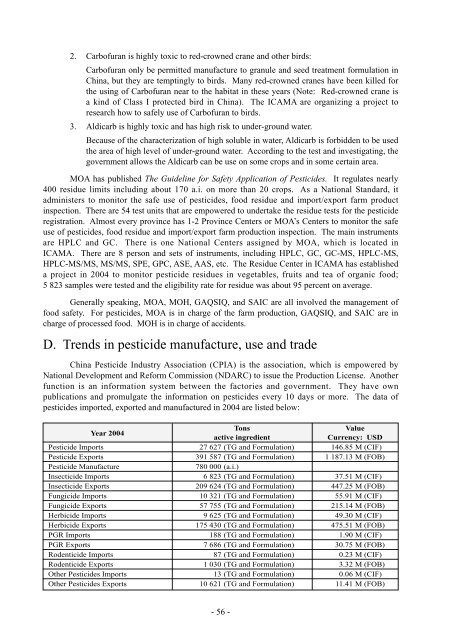Proceedings of the Asia regional workshop on the
Proceedings of the Asia regional workshop on the
Proceedings of the Asia regional workshop on the
You also want an ePaper? Increase the reach of your titles
YUMPU automatically turns print PDFs into web optimized ePapers that Google loves.
2. Carb<str<strong>on</strong>g>of</str<strong>on</strong>g>uran is highly toxic to red-crowned crane and o<str<strong>on</strong>g>the</str<strong>on</strong>g>r birds:<br />
Carb<str<strong>on</strong>g>of</str<strong>on</strong>g>uran <strong>on</strong>ly be permitted manufacture to granule and seed treatment formulati<strong>on</strong> in<br />
China, but <str<strong>on</strong>g>the</str<strong>on</strong>g>y are temptingly to birds. Many red-crowned cranes have been killed for<br />
<str<strong>on</strong>g>the</str<strong>on</strong>g> using <str<strong>on</strong>g>of</str<strong>on</strong>g> Carb<str<strong>on</strong>g>of</str<strong>on</strong>g>uran near to <str<strong>on</strong>g>the</str<strong>on</strong>g> habitat in <str<strong>on</strong>g>the</str<strong>on</strong>g>se years (Note: Red-crowned crane is<br />
a kind <str<strong>on</strong>g>of</str<strong>on</strong>g> Class I protected bird in China). The ICAMA are organizing a project to<br />
research how to safely use <str<strong>on</strong>g>of</str<strong>on</strong>g> Carb<str<strong>on</strong>g>of</str<strong>on</strong>g>uran to birds.<br />
3. Aldicarb is highly toxic and has high risk to under-ground water.<br />
Because <str<strong>on</strong>g>of</str<strong>on</strong>g> <str<strong>on</strong>g>the</str<strong>on</strong>g> characterizati<strong>on</strong> <str<strong>on</strong>g>of</str<strong>on</strong>g> high soluble in water, Aldicarb is forbidden to be used<br />
<str<strong>on</strong>g>the</str<strong>on</strong>g> area <str<strong>on</strong>g>of</str<strong>on</strong>g> high level <str<strong>on</strong>g>of</str<strong>on</strong>g> under-ground water. According to <str<strong>on</strong>g>the</str<strong>on</strong>g> test and investigating, <str<strong>on</strong>g>the</str<strong>on</strong>g><br />
government allows <str<strong>on</strong>g>the</str<strong>on</strong>g> Aldicarb can be use <strong>on</strong> some crops and in some certain area.<br />
MOA has published The Guideline for Safety Applicati<strong>on</strong> <str<strong>on</strong>g>of</str<strong>on</strong>g> Pesticides. It regulates nearly<br />
400 residue limits including about 170 a.i. <strong>on</strong> more than 20 crops. As a Nati<strong>on</strong>al Standard, it<br />
administers to m<strong>on</strong>itor <str<strong>on</strong>g>the</str<strong>on</strong>g> safe use <str<strong>on</strong>g>of</str<strong>on</strong>g> pesticides, food residue and import/export farm product<br />
inspecti<strong>on</strong>. There are 54 test units that are empowered to undertake <str<strong>on</strong>g>the</str<strong>on</strong>g> residue tests for <str<strong>on</strong>g>the</str<strong>on</strong>g> pesticide<br />
registrati<strong>on</strong>. Almost every province has 1-2 Province Centers or MOA’s Centers to m<strong>on</strong>itor <str<strong>on</strong>g>the</str<strong>on</strong>g> safe<br />
use <str<strong>on</strong>g>of</str<strong>on</strong>g> pesticides, food residue and import/export farm producti<strong>on</strong> inspecti<strong>on</strong>. The main instruments<br />
are HPLC and GC. There is <strong>on</strong>e Nati<strong>on</strong>al Centers assigned by MOA, which is located in<br />
ICAMA. There are 8 pers<strong>on</strong> and sets <str<strong>on</strong>g>of</str<strong>on</strong>g> instruments, including HPLC, GC, GC-MS, HPLC-MS,<br />
HPLC-MS/MS, MS/MS, SPE, GPC, ASE, AAS, etc. The Residue Center in ICAMA has established<br />
a project in 2004 to m<strong>on</strong>itor pesticide residues in vegetables, fruits and tea <str<strong>on</strong>g>of</str<strong>on</strong>g> organic food;<br />
5 823 samples were tested and <str<strong>on</strong>g>the</str<strong>on</strong>g> eligibility rate for residue was about 95 percent <strong>on</strong> average.<br />
Generally speaking, MOA, MOH, GAQSIQ, and SAIC are all involved <str<strong>on</strong>g>the</str<strong>on</strong>g> management <str<strong>on</strong>g>of</str<strong>on</strong>g><br />
food safety. For pesticides, MOA is in charge <str<strong>on</strong>g>of</str<strong>on</strong>g> <str<strong>on</strong>g>the</str<strong>on</strong>g> farm producti<strong>on</strong>, GAQSIQ, and SAIC are in<br />
charge <str<strong>on</strong>g>of</str<strong>on</strong>g> processed food. MOH is in charge <str<strong>on</strong>g>of</str<strong>on</strong>g> accidents.<br />
D. Trends in pesticide manufacture, use and trade<br />
China Pesticide Industry Associati<strong>on</strong> (CPIA) is <str<strong>on</strong>g>the</str<strong>on</strong>g> associati<strong>on</strong>, which is empowered by<br />
Nati<strong>on</strong>al Development and Reform Commissi<strong>on</strong> (NDARC) to issue <str<strong>on</strong>g>the</str<strong>on</strong>g> Producti<strong>on</strong> License. Ano<str<strong>on</strong>g>the</str<strong>on</strong>g>r<br />
functi<strong>on</strong> is an informati<strong>on</strong> system between <str<strong>on</strong>g>the</str<strong>on</strong>g> factories and government. They have own<br />
publicati<strong>on</strong>s and promulgate <str<strong>on</strong>g>the</str<strong>on</strong>g> informati<strong>on</strong> <strong>on</strong> pesticides every 10 days or more. The data <str<strong>on</strong>g>of</str<strong>on</strong>g><br />
pesticides imported, exported and manufactured in 2004 are listed below:<br />
Year 2004<br />
T<strong>on</strong>s<br />
active ingredient<br />
Value<br />
Currency: USD<br />
Pesticide Imports 27 627 (TG and Formulati<strong>on</strong>) 146.85 M (CIF)<br />
Pesticide Exports 391 587 (TG and Formulati<strong>on</strong>) 1 187.13 M (FOB)<br />
Pesticide Manufacture 780 000 (a.i.)<br />
Insecticide Imports 6 823 (TG and Formulati<strong>on</strong>) 37.51 M (CIF)<br />
Insecticide Exports 209 624 (TG and Formulati<strong>on</strong>) 447.25 M (FOB)<br />
Fungicide Imports 10 321 (TG and Formulati<strong>on</strong>) 55.91 M (CIF)<br />
Fungicide Exports 57 755 (TG and Formulati<strong>on</strong>) 215.14 M (FOB)<br />
Herbicide Imports 9 625 (TG and Formulati<strong>on</strong>) 49.30 M (CIF)<br />
Herbicide Exports 175 430 (TG and Formulati<strong>on</strong>) 475.51 M (FOB)<br />
PGR Imports 188 (TG and Formulati<strong>on</strong>) 1.90 M (CIF)<br />
PGR Exports 7 686 (TG and Formulati<strong>on</strong>) 30.75 M (FOB)<br />
Rodenticide Imports 87 (TG and Formulati<strong>on</strong>) 0.23 M (CIF)<br />
Rodenticide Exports 1 030 (TG and Formulati<strong>on</strong>) 3.32 M (FOB)<br />
O<str<strong>on</strong>g>the</str<strong>on</strong>g>r Pesticides Imports 13 (TG and Formulati<strong>on</strong>) 0.06 M (CIF)<br />
O<str<strong>on</strong>g>the</str<strong>on</strong>g>r Pesticides Exports 10 621 (TG and Formulati<strong>on</strong>) 11.41 M (FOB)<br />
- 56 -

















